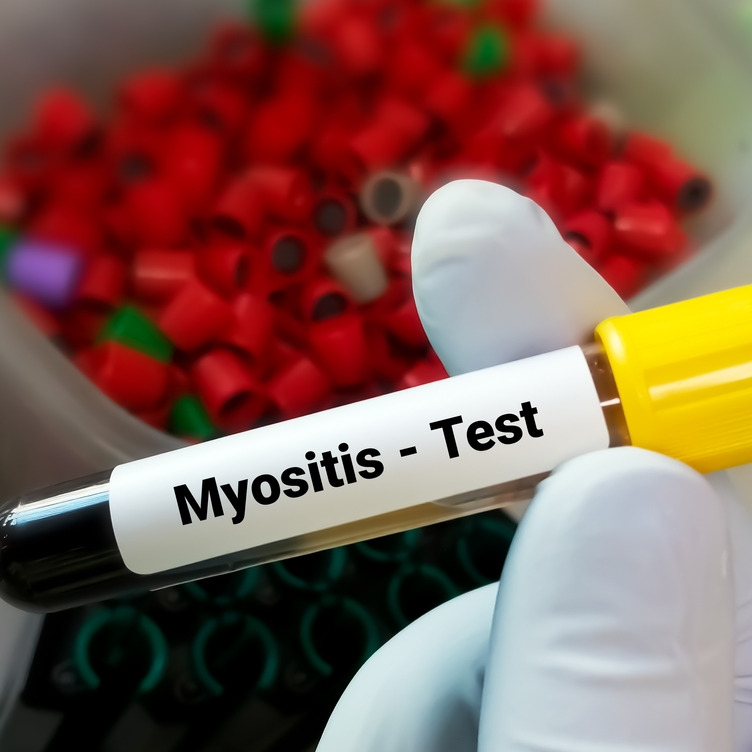
Myositis
Causes, symptoms and treatment options for inflammatory muscle disease
Myositis is a disease characterised by inflammation of the muscles and can take various forms.
This inflammatory muscle disease can be both acute and chronic and have various causes.
In this article, we will take an in-depth look at the causes, symptoms, diagnostic procedures and current treatment options for myositis in order to provide those affected and interested with a deeper understanding of this complex disease at .
What is myositis?
Myositis is the umbrella term for various inflammatory muscle diseases.
The inflammations can affect the skeletal musculature, i.e. the muscles that we can control voluntarily for movement, and they can have different causes.
Some forms of myositis include polymyositis, dermatomyositis and inclusion body myositis. Less common forms are granulomatous myositis and myositis in the context of infections or as a concomitant disease in other systemic diseases such as lupus.
Causes of myositis
The exact causes of myositis are not fully understood, but there are various factors that can contribute to the onset of the disease :
- Autoimmune reactions: In many sufferers, it is suspected that the immune system mistakenly attacks the body's own tissue, particularly the muscle fibres.
- Infections: certain viruses, bacteria or parasites can trigger myositis. For example, the so-called infectious myositis can be caused by influenza viruses.
- Medications and toxins: some medications and toxins can cause toxic myositis. These include statins, which are used to lower cholesterol levels.
- Genetic predisposition: in some forms of myositis, a genetic predisposition is recognisable, which indicates a familial clustering.
Symptoms of myositis
The symptoms of myositis can vary depending on the form and severity of the disease, but there are some common signs:
Muscle weakness: This is the most common symptom and usually affects the muscles of the hips, thighs, shoulders and upper arms. This muscle weakness can make it difficult to climb stairs, lift objects or stand up from a seated position.
- Muscle pain: Many patients report pain in the affected muscles.
- Muscle swelling: inflamed muscles may swell and be tender.
- Skin rash: In dermatomyositis, a skin rash often occurs, which can extend over the eyelids, neck, shoulders, upper body and joints .
- General malaise: fever , fatigue and a general feeling of illness may also occur.
Diagnosis of myositis
If myositis is suspected, a thorough medical examination is required. The following diagnostic procedures can be used :
- Blood tests: certain enzymes such as creatine kinase (CK) may be elevated in the blood and indicate muscle damage. In addition, blood tests are carried out for autoantibodies, which play a role in autoimmune diseases .
- Electromyography (EMG): in this examination, the electrical activity of the muscles is measured, which can provide indications of muscle damage.
- Magnetic resonance imaging (MRI): This can visualise inflamed areas in the muscles .
- Muscle biopsy: In this procedure, a small sample of muscle tissue is taken and analysed microscopically for signs of inflammation .
Treatment options for myositis
The treatment of myositis depends on the specific form of the disease and the severity of the symptoms. A multidisciplinary approach is often necessary, involving specialists in rheumatology, neurology, dermatology and physiotherapy. The following therapy options are available:
- Drug therapy: Corticosteroids are often used as first-line therapy to suppress the inflammation and immune response to . Other immunosuppressants or biologics can also be prescribed .
- Physiotherapy: A specially adapted training plan can help to maintain and improve muscle function.
- Nutrition: A balanced diet is important to avoid deficiencies and strengthen the muscles.
- Avoid triggers: if medications or toxins have triggered myositis , these should be avoided.
Living with myositis
Myositis is a chronic disease that can have a significant impact on the daily life of those affected. In addition to medical treatment, it is important that those affected receive support and adapt their lifestyle:
- Adaptation of activities: activities should be adapted so that they are compatible with the muscle weakness and do not cause overexertion .
- Support groups: sharing experiences with other sufferers can provide with emotional relief and helpful tips for everyday life.
- Psychological support: If necessary, psychological support can be helpful in dealing with the stresses and strains of the disease.
Conclusion
Myositis is a complex disease that can be a challenge to understand . However, early diagnosis and customised treatment can alleviate symptoms and improve quality of life . It is important that sufferers work closely with their medical team and keep up to date with the latest research and treatment options.
If you or a loved one is affected by myositis, do not hesitate to seek professional help and learn about the many resources that are available. Through knowledge, support and a proactive approach, dealing with myositis can be better managed.
Become a member now
As a member, you will receive further information and frequencies on this topic! Log in here!
